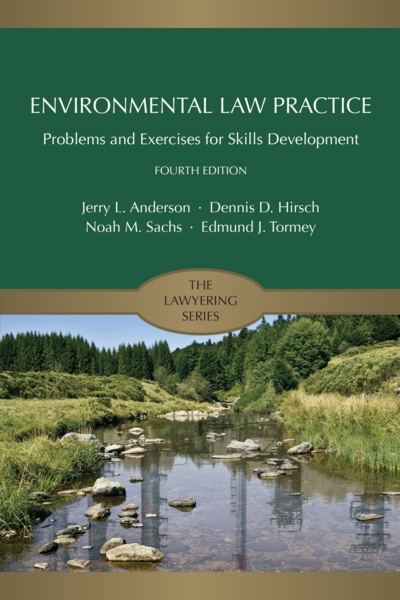Environmental Law Practice
Problems and Exercises for Skills Development
Fourth Edition
by Jerry L. Anderson, Dennis D. Hirsch, Noah M. Sachs, Edmund J. Tormey
2018
Tags: Environmental/Energy and Resources Law, Lawyering Series
Teacher's Manual available
412 pp $55.00
ISBN 978-1-5310-0531-3
eISBN 978-1-5310-0373-9
Adopted at dozens of law schools, this book is a valuable resource for imparting practical skills. Authors Anderson, Hirsch, Sachs, and Tormey have drawn on their wide experience as environmental law professors and practitioners to develop realistic exercises that teach the craft of environmental lawyering. Readers will learn how to bring a federal enforcement action against a polluter; negotiate a Superfund settlement; prepare documents and strategy for a citizen's suit; counsel a corporation on environmental compliance; navigate the issues that arise in government agency litigation (e.g., limits on discovery, standards of review); comment on EPA rule making; and handle environmental issues that arise in permitting a complex real estate development, as well as many other relevant skills.
Updated and expanded, the fourth edition of Environmental Law Practice is comprehensive in scope. It contains problems and exercises under each of the major environmental statutes. In addition, it places readers in the three key roles played by environmental lawyers—government attorney, corporate counsel, and public interest advocate—and provides practice pointers for each of these types of work. The book makes extensive use of original documents such as statutes, the Code of Federal Regulations (CFR), regulatory preambles, and agency guidance, exposing students to the materials that environmental lawyers use most.
This book covers the most significant areas of environmental practice: compliance, enforcement, litigation, permitting, and policy. It gives in-depth treatment of substantive environmental law areas such as the Clean Air Act, Clean Water Act, CERCLA, RCRA, EPCRA, NEPA, and citizen suits. It incorporates current developments in environmental law, such as recent Supreme Court and circuit court cases. Of the many books on environmental law, Environmental Law Practice is the one to use to develop the skills to become a practice-ready environmental attorney.
One of the most striking failures of most law schools' curriculum design is the failure to teach the art of hands-on regulatory practice—researching, interpreting, and applying administrative rules and guidelines—which according to some savants affects 80 percent or more of all modern legal practice. Anderson, Hirsch, Sachs, and Tormey provide the cure. I use their book as an adjunct to the basic Environmental Law course; others use it as a freestanding elective. Either way, the book is an eye-opener for students, giving them what is often their first and only competent entrée into the world of regulatory practice. Looking back on the exercises, my students tell me they cannot imagine how they could have felt confidence in their understanding of the field, and by extension other fields of law as well, if they hadn't had a teacher wise enough to introduce them to this book."
— Zygmunt Plater, Professor of Law, Boston College Law School
This book is part of the Lawyering Series, edited by Roger I. Abrams of Northeastern Law School.
Comp Copy If you are a professor teaching in this field you may request a complimentary copy.


